The Bulldozer Review: AMD FX-8150 Tested
by Anand Lal Shimpi on October 12, 2011 1:27 AM ESTThe Test
To keep the review length manageable we're presenting a subset of our results here. For all benchmark results and even more comparisons be sure to use our performance comparison tool: Bench.
| Motherboard: |
ASUS P8Z68-V Pro (Intel Z68) ASUS Crosshair V Formula (AMD 990FX) |
| Hard Disk: |
Intel X25-M SSD (80GB) Crucial RealSSD C300 |
| Memory: | 2 x 4GB G.Skill Ripjaws X DDR3-1600 9-9-9-20 |
| Video Card: | ATI Radeon HD 5870 (Windows 7) |
| Video Drivers: | AMD Catalyst 11.10 Beta (Windows 7) |
| Desktop Resolution: | 1920 x 1200 |
| OS: | Windows 7 x64 |
Windows 7 Application Performance
3dsmax 9
Today's desktop processors are more than fast enough to do professional level 3D rendering at home. To look at performance under 3dsmax we ran the SPECapc 3dsmax 8 benchmark (only the CPU rendering tests) under 3dsmax 9 SP1. The results reported are the rendering composite scores.

As our first heavily threaded, predominantly FP workload we see the FX-8150 come out swinging. A tangible upgrade from the Phenom II X6, the 8150 is hot on the heelds of the Core i5 2400, however it is unable to compete with the 2500K and 2600K.
Cinebench R10 & 11.5
Created by the Cinema 4D folks we have Cinebench, a popular 3D rendering benchmark that gives us both single and multi-threaded 3D rendering results.
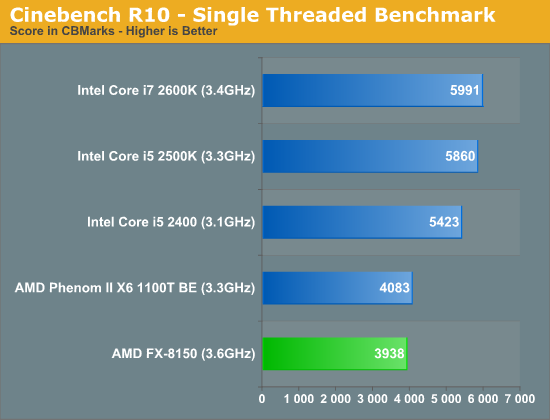
As I alluded to earlier, single threaded performance is going to be a bit of a disappointment with Bulldozer and here you get the first dose of reality. Even considering its clock speed and Turbo Core advantage, the FX-8150 is slower than the Phenom II X6 1100T. Intel's Core i5 2500K delivers nearly 50% better single threaded performance here than the FX-8150.
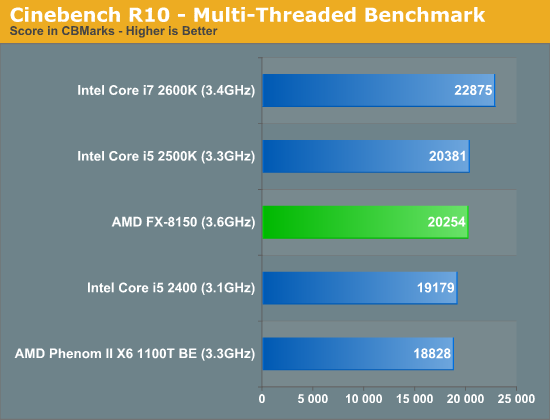
Crank up the threads and the FX-8150 shines, finally tying the 2500K at a comparable price point.
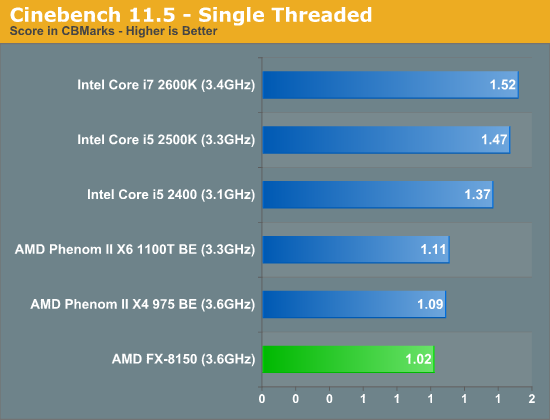
Even with more modern workloads, the FX-8150 isn't able to compete in single threaded speed. Here the 2500K is 44% faster.
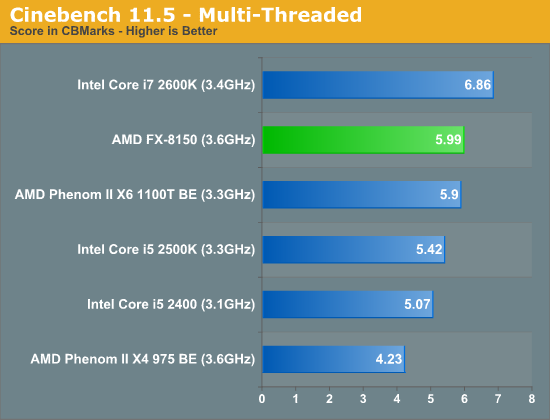
Modern multithreaded workloads however do quite well on Bulldozer. The gains over the old Phenom II X6 1100T are unfortunately not as large as we would expect them to be.
7-Zip Benchmark
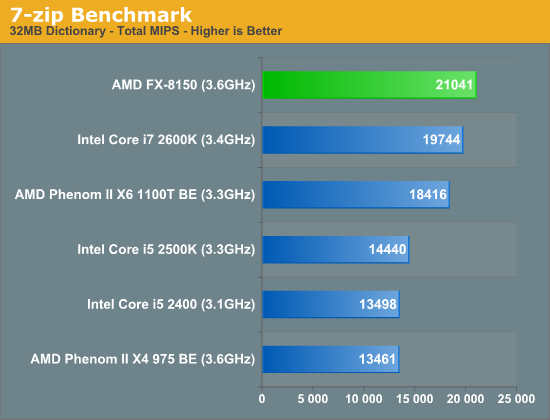
Heavily threaded workloads obviously do well on the FX series parts, here in our 7-zip test the FX-8150 is actually faster than Intel's fastest Sandy Bridge.
PAR2 Benchmark
Par2 is an application used for reconstructing downloaded archives. It can generate parity data from a given archive and later use it to recover the archive
Chuchusoft took the source code of par2cmdline 0.4 and parallelized it using Intel’s Threading Building Blocks 2.1. The result is a version of par2cmdline that can spawn multiple threads to repair par2 archives. For this test we took a 708MB archive, corrupted nearly 60MB of it, and used the multithreaded par2cmdline to recover it. The scores reported are the repair and recover time in seconds.
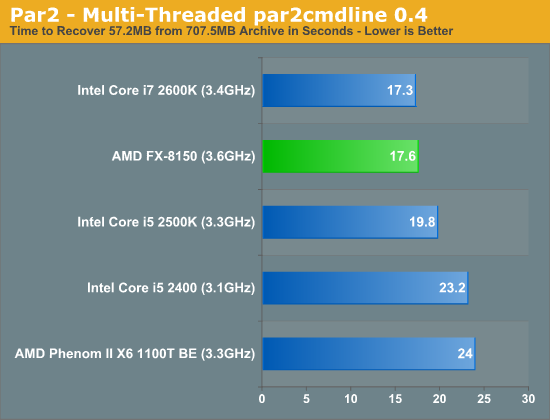
Once again, throw more threads at the processor and the FX-8150 can outperform the Core i5 2500K.
TrueCrypt Benchmark
TrueCrypt is a very popular encryption package that offers full AES-NI support. The application also features a built-in encryption benchmark that we can use to measure CPU performance with:
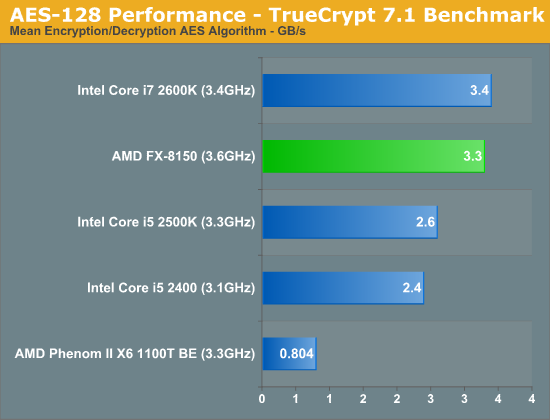
Bulldozer adds AES-NI acceleration, a feature that wasn't present in the Phenom II X6. As a result the FX-8150 is among the fastest at real time AES encryption/decryption, second only to the 2600K. Intel's artificial segmentation using Hyper Threading comes back to haunt it here as the 2500K is significantly slower than the 8-threaded beast.
x264 HD 3.03 Benchmark
Graysky's x264 HD test uses x264 to encode a 4Mbps 720p MPEG-2 source. The focus here is on quality rather than speed, thus the benchmark uses a 2-pass encode and reports the average frame rate in each pass.
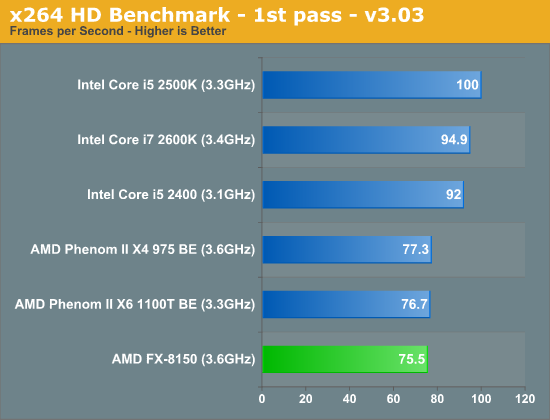
As I mentioned earlier, the first pass of our x264 HD benchmark is a lightly threaded task. As such, the FX-8150 doesn't do very well here. Even the old Phenom II is able to inch ahead of AMD's latest. And Sandy Bridge obviously does very well.

The second pass is more thread heavy, allowing the FX-8150 to flex its muscle and effectively tie the 2600K for first place.
AMD also sent along a couple of x264 binaries that were compiled with AVX and AMD XOP instruction flags. We ran both binaries through our x264 test, let's first look at what enabling AVX does to performance:
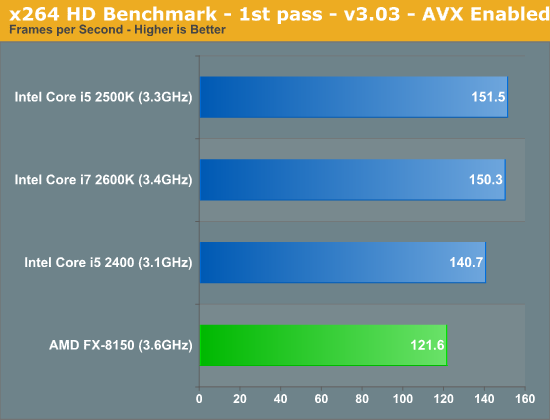
Everyone gets faster here, but Intel continues to hold onto a significant performance lead in lightly threaded workloads.
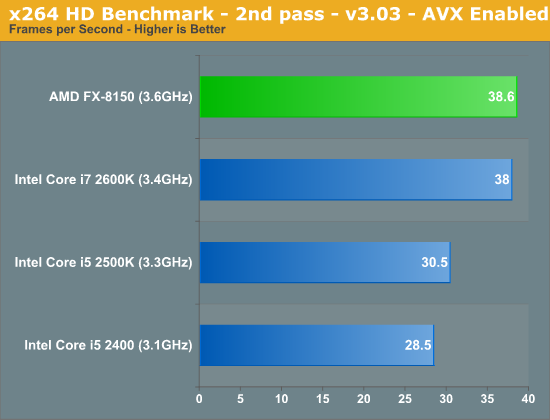
The standings don't change too much in the second pass, the frame rates are simply higher across the board. The FX-8150 is an x86 transcoding beast though, roughly equalling Intel's Core i7 2600K. Although not depicted here, the performance using the AMD XOP codepath was virtually identical to the AVX results.
Adobe Photoshop CS4
To measure performance under Photoshop CS4 we turn to the Retouch Artists’ Speed Test. The test does basic photo editing; there are a couple of color space conversions, many layer creations, color curve adjustment, image and canvas size adjustment, unsharp mask, and finally a gaussian blur performed on the entire image.
The whole process is timed and thanks to the use of Intel's X25-M SSD as our test bed hard drive, performance is far more predictable than back when we used to test on mechanical disks.
Time is reported in seconds and the lower numbers mean better performance. The test is multithreaded and can hit all four cores in a quad-core machine.
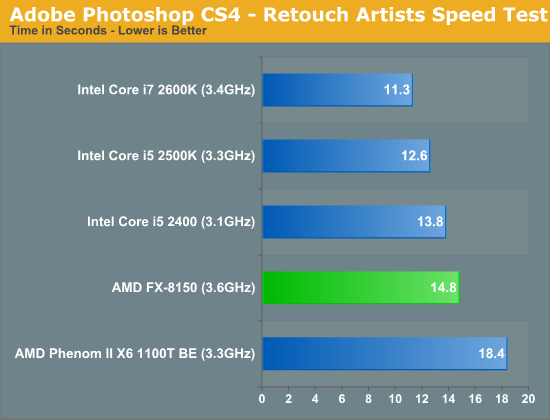
Photoshop performance improves tangibly over the Phenom II X6, unfortunately it's not enough to hang with the enthusiast Sandy Bridge parts.
Compile Chromium Test
You guys asked for it and finally I have something I feel is a good software build test. Using Visual Studio 2008 I'm compiling Chromium. It's a pretty huge project that takes over forty minutes to compile from the command line on a dual-core CPU. But the results are repeatable and the compile process will easily stress more than 8 threads on a CPU so it works for me.
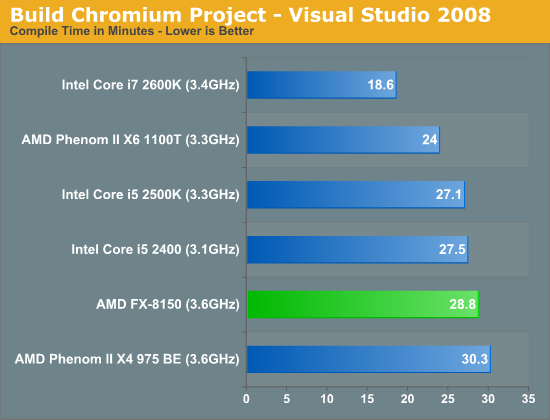
Our compiler test has traditionally favored heavily threaded architectures, but here we found the Phenom II X6 1100T to offer a tangible performance advantage over Bulldozer. While AMD is certainly competitive here, this is an example of one of those situations where AMD's architectural tradeoffs simply don't pay off—not without additional clock speed that is.
Excel Monte Carlo

Our final application test is another win for AMD over the Core i5 2500K. The victory is entirely a result of Intel's Hyper Threading restrictions though, the eight-thread 2600K is able to easily outperform Bulldozer. Either way, AMD delivers better performance here for less money.










430 Comments
View All Comments
actionjksn - Thursday, October 13, 2011 - link
AMD Nailpuller? That was some funny shit right there HA HA HASpam not Spam - Wednesday, October 12, 2011 - link
Just skimmed the review; not as awesome as I had hoped for, sadly. That being said, I'm thinking it might well be a nice improvement for the stock, C2D Q6600 in my Dell. I could go Intel, obviously, but... I dunno. I've got an odd fascination with novel things, even if they are rough to begin with. Hell, I've even got a WP7 phone :pwolfman3k5 - Wednesday, October 12, 2011 - link
Then make sure to get a quality power supply and motherboard to go with it. Also, your power bill will increase, but not directly from the Bulldozer CPU, nope, but from all the heat that it will make... you will need to run your air conditioner which is a power hog./* Patiently waiting for AMD's next gen architecture codenamed "Bendover" */
ckryan - Wednesday, October 12, 2011 - link
Is 'ScrewdOver' next on the roadmap after 'Bendover'? I'll have to look in the official AMD leaked slide repository.I still think some intrepid AMD faithful will try BD out just because they're wired that way, and many of the are going to like it. I bet it compares better to Lynnfield than Sandy Bridge... Except Ivy Bridge is closer in the future than SB's launch is in the past. This could be an interesting and relevant product after a few years, but the need is dire now. AMD is going to kill off the Phenom II as fast as possible.
themossie - Wednesday, October 12, 2011 - link
Bendover -> ScrewdOver -> Screwdriver (I'll bring the OJ) -> Piledriver.Courtesy of numerous internal leaks at AMD.
themossie - Wednesday, October 12, 2011 - link
My apologies, didn't realize Piledriver was real.bill4 - Wednesday, October 12, 2011 - link
AKA, the reason all of us who are commenting are reading this review. Gaming performance. And AMD chose not to even compete there. Bunch of monkey overs at AMD CPU engineering?It's now a non starter in the enthusiast market.
I've often though recently that AMD (or any manufacturer really, but AMD as a niche filler would be a more obvious choice given their market position) would do well to try to position itself as the gamers choice, and even design it's CPU's to excel in gaming at the expense of some other things at times. I really suspect this strategy would lead to a sales bonanza. Because really the one area consumers crave high performance is pretty much, only gaming. It's the one reason you actually want a really high performance CPU (provided you dont do some sort of specialized audio/video work), instead of just "good enough" which is fine for general purpose desktoping.
Instead they do the exact opposite with Bulldozer, facepalm. Bulldozer is objectively awful in gaming. Single handedly nobody who posts at any type of gaming or gaming related forum will ever buy one of these. Unbelievable.
Perhaps making it even more stinging is there was some pre-NDA lift supposed reviewer quote floating around at about how "Bulldozer will be the choice for gamers" or something like that. And naturally everybody got excited because, that's all most people care about.
Combine that with the fact it's much bigger and hotter than Intel's, it's almost a unmitigated disaster.
This throws AMD's whole future into question since apparently their future is based on this dog of a chip, and even makes me wonder how long before AMD's engineers corrupt the ATI wing and bring the GPU side to disaster? The ONLY positive thing to come out of it is that at least AMD is promising yearly improvements, key word promising. Even then absolute best case scenario is that they slowly fix this dog in stages, since it's clearly a broken architecture. And that's best case, and assumes they will even meet their schedule.
Anand lays so much of the blame at clockspeed, hinting AMD wanted much more. But even say, 4.3 ghz Bulldozer, would STILL be a dog in all important gaming, so there's little hope.
shompa - Wednesday, October 12, 2011 - link
I have used many AMD systems. Have deployed 1000 of AMD CPU inside Unix workstations at my old work. I cheer for AMD.But.
AMD is going to have a hard time ahead. Selling its fabs to Global foundries was the biggest mistake of them all.
We are in the post PC world. If Tablets are computers: 2012 20% of PCs will use ARM. This is many lost CPU sales for AMD/Intel.
I predict that AMD will be gone within 3 years. Maybe someone buys them? After the settlement with Intel, AMD now can transfer its X86 license to the next buyer. (pending Intels approval)
Maybe Google could buy AMD and build complete computers ?
wolfman3k5 - Wednesday, October 12, 2011 - link
I see two things that might happen to AMD1) They will transform in to a GPU manufacturer completely (and of course they will make those silly APUs)
2) If that damn x86 license is transferable, they could merge with NVidia. Neither of these two companies looks to hot these days, so they might as well work together.
philosofool - Thursday, October 13, 2011 - link
We may be in the "post PC" era, but don't count x86 out. Recent studies indicate there's a corollary to Moore's law that applies to compute power per watt; the study goes back to 1961. This suggests that x86 is only a few years away from running on mobile devices, which is what MS and Intel are betting on. And frankly, it makes sense. Ultimately, I don't want two different things (a mobile device and a PC), I want a PC in my pocket and one on my desk.